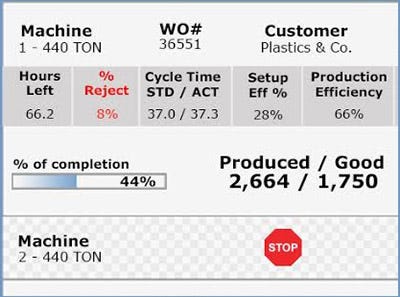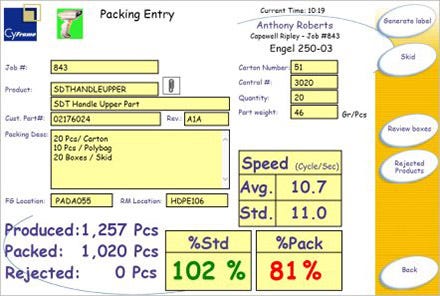Improving manufacturing efficiency, reducing inventory, lowering waste, and maintaining product quality should be meticulously tracked, but for a plastics processor the most critical measure of performance is mold cycle time.
November 2, 2021

Key performance indicators (KPIs) provide the insight to quickly respond to changing conditions and immediate threats, or to implement subtle adjustments to keep the business trending in a healthy direction. And while there are any number of important areas to track, one indicator is unquestionably the most critical and should sit at the top of the list for any plastics processor.
One could make a strong case for collecting and analyzing metrics associated with improved efficiency or responsiveness, reducing inventory, lowering waste, and of course maintaining product quality. Each of these areas is vastly important to the health of the company and should be meticulously tracked. But for a plastics manufacturer, the most critical measure of performance is mold cycle time. Cycle time is the total time required to mold a single shot of plastic — from the injection of plastic into the mold to the beginning of the next plastic injection.
Let’s establish from the start that cycle time is variable and influenced by several factors — mold design, cavity (part) configuration, the material being molded. These and other factors will impact the time required to inject the plastic into the mold, cool the plastic, open the mold, eject the part(s), and re-close the mold. Similarly, the time it takes for material to cool depends on the characteristics of the cooling lines designed into the mold and thickness of the molded material (part size and geometry).
|
Companies typically measure mold cycle time after the fact. This does little to support operational improvement. |
The best way to determine cycle time
While basic (theoretical) cycle time is designed into the process and the mold, the operator and operational conditions will have a definite influence over the actual cycle time. Most companies only measure mold cycle time indirectly and after the fact. This is typically determined simply by dividing the total time needed to produce a run of product by the number of parts (cycles) produced. Though this may be useful for accounting and engineering purposes, such information does little to support work management and operational improvement.
The best option is to continuously measure, analyze, and display the cycle time throughout a given shift. In this way, management can keep a close eye on the actual performance of the central resource of a molding plant and ensure that the facility is operating at full capacity in real time.
The design of the mold and the process itself dictate the theoretical operating cycle time. This can be considered the optimal, or best, overall cycle. While running slower than the theoretical optimum, of course, is less productive and inefficient, running faster than the designed cycle is not necessarily a good thing, either. For example, if the cycle time should be 11 seconds, but the job is running at 10 seconds, the product may appear to be fine coming off the machine yet may have hidden flaws causing it to fail a downstream quality inspection. In this instance, continuous cycle time monitoring will trigger an immediate alert to quickly check product quality and take corrective action to prevent the production of additional soon-to-be-scrapped parts. Most often, the recommended best practice is to strive to consistently maintain the theoretical rate — no more and no less.
Every second counts . . . really
Operator actions, equipment condition and maintenance, and ambient conditions will impact mold cycle time. Early detection of any inhibitor allows a quick response for corrections and increased output.
Machines that have been well maintained will be faster and more reliable, yielding more consistent performance. Similarly, operator experience and expertise can have a significant influence on the mold cycle and productivity of the machine and, ultimately, the plant. It is essential to have a system that is continually tracking historical cycle time, managing maintenance schedules, and determining what each machine’s cycle time should be to increase overall productivity and profitability. What’s more, data from such a system allows for far better planning and scheduling.
Let’s assume that a mold is designed for a cycle of 10 seconds. To maintain his/her duties and produce good parts, a less experienced operator might run the machine on an 11-second cycle. You might wonder: What real difference does a second make? That additional second of cycle time represents a 10% reduction in productivity. The cumulative effect of this means that a given job will take 10% longer to complete and the overall output of the machine per shift is reduced by 10%. Bringing the machine back up to the designed speed results in an 11% improvement over the reduced rate (dividing nine seconds into 10 to get the improvement percentage) with the accompanying increase in efficiency, productivity, and reduced cost.
So, as you can see, time really is money . . . every single second.
Optimizing machine selection
Tracking mold performance (cycle time) by machine also provides an opportunity to better manage the plant and achieve optimum throughput. A given mold might operate effectively at a 10-second cycle on one machine but at eight seconds on another.
All other things being equal, it might be more advantageous to run the job on the second machine. Considering pending jobs and their specific run rates, color changes, priorities, maintenance schedules, operator availability, and other factors may favor alternative assignments. These decisions are difficult at best without good performance information by mold, machine, and operator.
|
A relatively small investment in data collection can considerably increase production efficiency. |
Big return on investment
Another measurement opportunity exists through a constant check on cycle time compared with pack efficiency. Automated shop floor inputs from the machine, compared directly with bar code scans of what is being packed, can maintain a running count of job progress and quality (rejects). This provides continuous, real-time data for planning when the current job can ship and when the next job can start. Moreover, this delivers an added benefit of tracking raw material usage more precisely.
In most cases, simple machine monitoring sensors integrated or retrofitted into machine controls can be used to feed data collection and analysis functions in a planning and management system. A relatively small investment in data collection provides input that generates better scheduling, more effective operating and plant management, and an overall efficiency increase.
Know the warning signs
There are indicators all around us. That console light lets us know when the car needs service. A smoke alarm will chirp when the battery is low. The bank might send a text when funds are depleted.
While manufacturers don’t have flashing “low productivity” alerts, there are clear signs of underperformance and trouble if you know where to look and how to prioritize their importance. For plastics processors, mold cycle time is the most critical measure of performance.
About the author
Pierre Maillet is President of CyFrame International Enterprises Inc. A graduate of the University of Ottawa, Maillet is a CPA. Prior to CyFrame, he worked as a Software Applications Specialist (Hewlett Packard) and IT Management Consultant (KPMG). Today, as head of CyFrame, Maillet helps tooling/plastics manufacturers improve production efficiency and profitability.
About the Author(s)
You May Also Like






